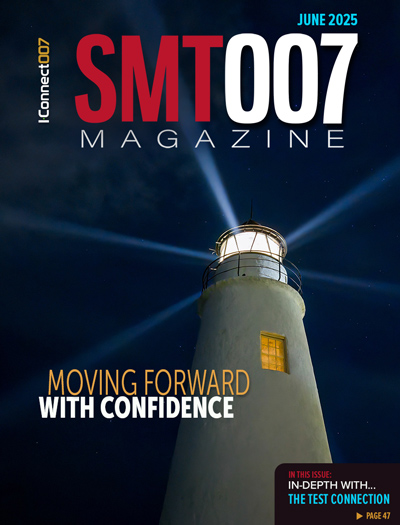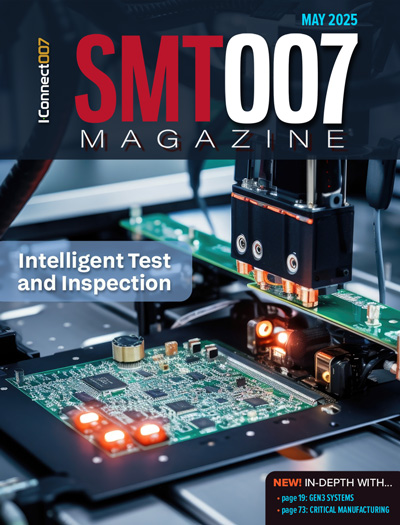-

- News
- Books
Featured Books
- smt007 Magazine
Latest Issues
Current Issue
What's Your Sweet Spot?
Are you in a niche that’s growing or shrinking? Is it time to reassess and refocus? We spotlight companies thriving by redefining or reinforcing their niche. What are their insights?

Moving Forward With Confidence
In this issue, we focus on sales and quoting, workforce training, new IPC leadership in the U.S. and Canada, the effects of tariffs, CFX standards, and much more—all designed to provide perspective as you move through the cloud bank of today's shifting economic market.

Intelligent Test and Inspection
Are you ready to explore the cutting-edge advancements shaping the electronics manufacturing industry? The May 2025 issue of SMT007 Magazine is packed with insights, innovations, and expert perspectives that you won’t want to miss.
- Articles
- Columns
- Links
- Media kit
||| MENU - smt007 Magazine
SMTAI 2019: Happy Holden’s On-the-Scene Report
October 3, 2019 | Happy Holden, I-Connect007Estimated reading time: 2 minutes
Last week concluded the 2019 SMTAI conference in Rosemont, Illinois. Overall, I think the show was successful and covered all aspects of SMT processes.
Professional development courses were held on Sunday and Monday, which were useful for anyone new to SMT and those wishing to increase their specific knowledge. Technical sessions started on Monday and ran through Thursday. Monday was also set aside for the Women’s Leadership Program, and mid-day, we received another update on the IPC’s Weak Microvia Interface Program investigating the root causes of a new reliability failure in stacked microvias. IPC will work with the European Space Agency on their HDI space qualification study.
Tuesday saw the first keynote delivered by Adam Steltzner, Ph.D., from NASA’s Jet Propulsion Laboratory (JPL) who talked about, “The Right Kind of Crazy: A True Story of Teamwork, Leadership, and High-Stakes Innovation.” Adam gave a very interesting and entertaining presentation about how his team at JPL came up with the soft-landing method, also called “the sky crane,” for the last Mar’s Curiosity Rover—a real problem never tackled before for a 900-kg vehicle the size of an automobile. They also had no way to test it completely on the Earth—only through simulations.
The Young Professionals Program started on Tuesday, and the exhibition opened the same day; both continued through Wednesday. Further, Wednesday continued with a keynote by W. Michael Hawes, D.Sc., from Lockheed Martin Space with “To the Moon and Back: Orion’s Next Jump Into Deep Space.” Dr. Hawes provided a review of NASA’s Orion Program to go back to the moon and stay this time.
At the exhibition, there was enough representation of vendors present to showcase the latest technologies (e.g., SMT pick-and-place equipment by Panasonic, Fuji; solder paste materials by Indium and Kester, etc.). There was a relatively large number of X-ray and optical inspection equipment vendors offering more or less the same functional products. Unlike Nordson and Koh Young, most of the vendors are new in the X-ray inspection sector.
Laserssel offers a unique selective solder reflow equipment. Compared with conventional reworking with a hot air gun (for both array and peripheral packages and soldering iron (for peripheral packages) at prolonged heating, Laserssel’s equipment enables fast and effective rework of assembled devices with minimum impact to neighboring devices. Also, Kurtz Ersa showed a fixture-free board routing technique that uses strong magnetic tooling pins precisely placed on a routing table by a robotic arm. Multiple pins are digitally placed around four corners of the panel to make it square, and some pins are placed under the panel for support during routing operation.
I also noted that many vendors sported banners stating that they were compliant with IPC-Connected Factory Exchange (CFX). Smart factory automation has increased in applications. One particular new exhibitor was Seica S.p.A. of Italy, which makes AOI inspection equipment for SMT assembly and bare boards. What caught my eye was their small connection box—the ShoeBox—that will enable older equipment to connect into the new IPC-CFX network. The ShoeBoxes, one as a monitor and one as a master, utilize the Raspberry Pi computer and its 40-pin general-purpose input/output (GPIO) to provide analog-digital lighting power, timing, and message control for existing equipment via two different wireless radio and one power line channels to an Ethernet local area network (LAN) of 10/100 Mbps for Modbus or IPC-CFX protocols.
The exhibits closed on Wednesday with a gala of apps and refreshments. I hope to see many of you next year.
Suggested Items
Driving Innovation: Direct Imaging vs. Conventional Exposure
07/01/2025 | Simon Khesin -- Column: Driving InnovationMy first camera used Kodak film. I even experimented with developing photos in the bathroom, though I usually dropped the film off at a Kodak center and received the prints two weeks later, only to discover that some images were out of focus or poorly framed. Today, every smartphone contains a high-quality camera capable of producing stunning images instantly.
Hands-On Demos Now Available for Apollo Seiko’s EF and AF Selective Soldering Lines
06/30/2025 | Apollo SeikoApollo Seiko, a leading innovator in soldering technology, is excited to spotlight its expanded lineup of EF and AF Series Selective Soldering Systems, now available for live demonstrations in its newly dedicated demo room.
Indium Corporation Expert to Present on Automotive and Industrial Solder Bonding Solutions at Global Electronics Association Workshop
06/26/2025 | IndiumIndium Corporation Principal Engineer, Advanced Materials, Andy Mackie, Ph.D., MSc, will deliver a technical presentation on innovative solder bonding solutions for automotive and industrial applications at the Global Electronics A
Fresh PCB Concepts: Assembly Challenges with Micro Components and Standard Solder Mask Practices
06/26/2025 | Team NCAB -- Column: Fresh PCB ConceptsMicro components have redefined what is possible in PCB design. With package sizes like 01005 and 0201 becoming more common in high-density layouts, designers are now expected to pack more performance into smaller spaces than ever before. While these advancements support miniaturization and functionality, they introduce new assembly challenges, particularly with traditional solder mask and legend application processes.
Knocking Down the Bone Pile: Tin Whisker Mitigation in Aerospace Applications, Part 3
06/25/2025 | Nash Bell -- Column: Knocking Down the Bone PileTin whiskers are slender, hair-like metallic growths that can develop on the surface of tin-plated electronic components. Typically measuring a few micrometers in diameter and growing several millimeters in length, they form through an electrochemical process influenced by environmental factors such as temperature variations, mechanical or compressive stress, and the aging of solder alloys.


